This isn’t your typical Metatrader expert adviser app – where you must load it and maintain it on every open chart you’re working with.
The master panel can be used in a specific and convenient way that is far superior in coverage.
Let’s dive in and learn how the panel works, and the basic instructions of use.
The Master Panel
The mission when designing this panel was to break away from the ‘typical’ use of an expert adviser tool for Metatrader that requires loading and maintaining on every chart your trading it with.
Usually this creates clutter, a messy work space, and may slow your computer down if you’re running too many instances of the same tool.
With this trade panel, we only need to have one panel open – the ‘Master’ Panel.
The first instance of the panel you open will be loaded automatically as the master panel. Only one master panel can be active at a time, any other panel opened after it will become a child panel.
The master panel is easily identifiable in two ways.
- There is a ‘master’ flag in the title bar
- An extra tab will appear called the trade monitor
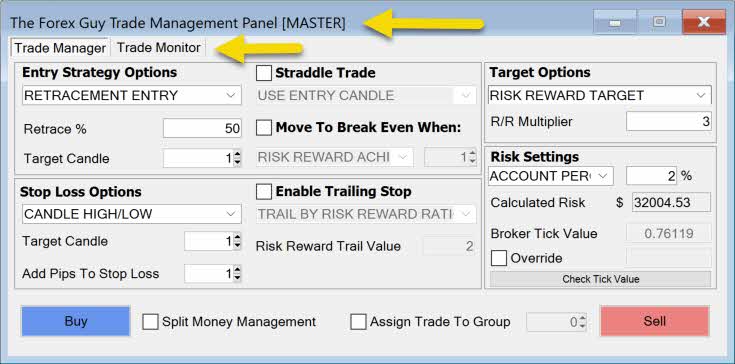
The master panel is the only one that will manage all the trades (that need managing).
Any trade opened by any panel will have its control sent directly to the master panel.
If you close the master panel (accidentally or intentional), the program will search for any other open panels and promote them to master.
A warning prompt will also appear if you try to close the master panel, just to verify you want it to be shut down.
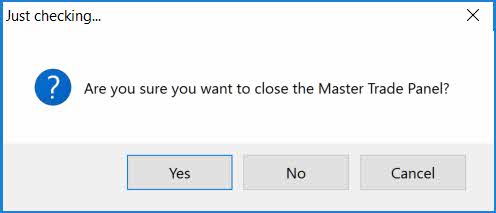
These are fail safe mechanisms to try keep one master panel open at all times, because without a master panel, you’re trades will not be managed (trailing stops, order cancels order etc.)
This allows all your trades to be managed from one central location, even if you have opened trades from different instruments.
Checkpoint
A Basic Trade Example
The panel can place any kind of trade from simple to advanced configurations. The great advantage of using the panel for simple trades are for things like auto lot-size calculation, auto spread-factorization, speed and convenience. Let’s look at an example:
To place a simple trade, the panel is going to need the following –
- An entry strategy
- A stop loss strategy
- Trade risk input
- Target strategy (optional)
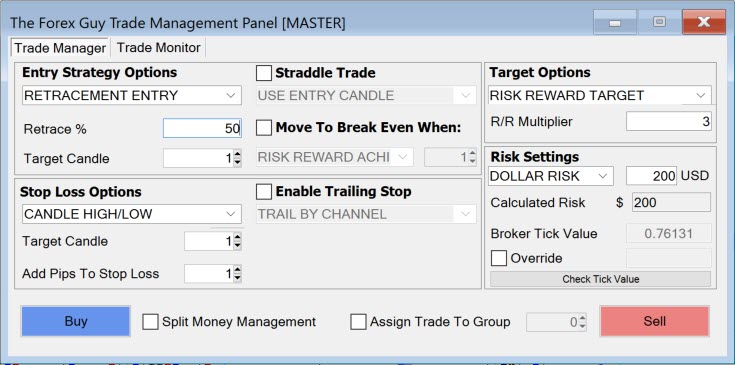
The panel above is configured to execute a trade with:
- 50% retracement on the previous candle
- Stop loss placed above the high or below the low of the previous candle (depending if we buy or sell)
- $200 risk on the trade
- Target has been set to 1:3 risk/reward, but we could have had no target set here if we wanted
Simply click buy or sell button and the panel will take care of the rest for you.
The panel will automatically determine if you need a limit, stop or market order by itself.
Important Note: Be aware that Metatrader has an internal limit on how close to actual market price you’re allowed to set limit or stop orders. If your entry price is within that restricted buffer zone, the panel will just use a market order.
We will look at the different entry and stop strategies later in this tutorial series.
Checkpoint
Trade Monitor
If you have placed a more advanced trade that needs further attention or care after it has been executed, you will find it in the master trade panel monitor.
The monitor is there for convenience so you can see what trades are currently being looked after by the panel.
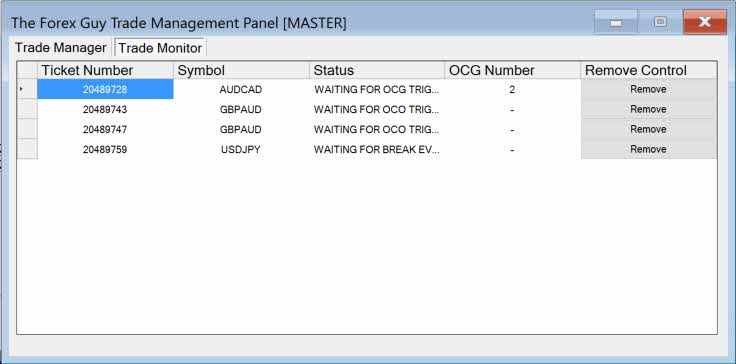
Trades that will end up in the trade monitor are –
- OCO orders (‘Get Me in the Damm Trade’ entry strategy)
- OCG orders – the pending orders you assigned to a group
- Trades with trailing stop losses applied
- Traded with a break even stop loss event
- Straddle Trades
Trades with strategies listed above need constant monitoring, and adjusting.
If a trade setup is executed by the panel that does not require any post maintenance, it will not appear in the monitor.
If for some reason you don’t want the panel to monitor that trade anymore, you can ‘disconnect’ the trade from the panel by clicking the remove button in the trade monitor.
Just be aware this action is non-reversible. So, if you have a trade with an active trailing stop and you click the remove button, the panel will remove the trade from it’s watch list and the trailing stop will terminate.
Clicking the remove button does not delete the trade order.
Checkpoint
Child Panels
A child panel is one that is opened after a master panel already exists, and does not contain any of the features, or authority that the master panel has, like the trade monitor.
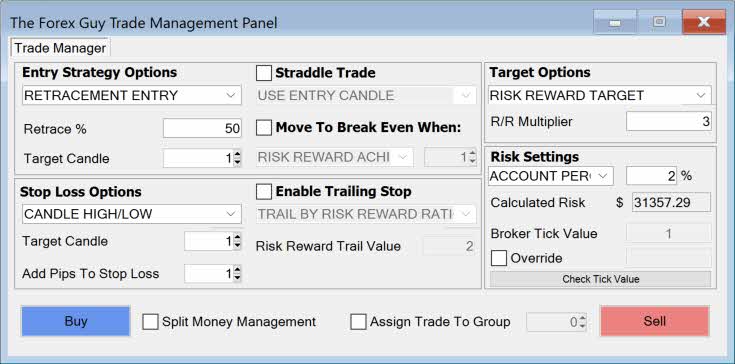
The first time you load the panel, it will load as the master panel. But if you load any further panels while a master panel is already active, you will just get a simple child panel.
In this case, the child panel will just become an interface for placing trades. Once you’ve finished placing trades on a child panel, you may close it – no prompt will appear asking if you want to close.
All trade data is sent to the master panel, and if it needs maintenance then you will find the trade displayed in the master panel’s trade monitor.
Checkpoint
Auto Saving & Restore Feature
Each time you place a trade, the panel will automatically save your trade data to a file on disk.
This is useful if your panel experiences an unintended shut down, like a blackout or computer crash. If the panel was busy monitoring or attending to trades, then no need to worry, all the trade data is backed up in the restore file.
Only the master panel has the authority to access the restore file.
When you load a master panel, it will scan the restore file and analyze the trade configuration data. Any active trades it finds that still need attention, it will reintegrate into its control, and put them back in the trade monitor.
If the master panel detects any trades on load that it needs to restore, you will get a message telling you there was x amount of successful trades restored.
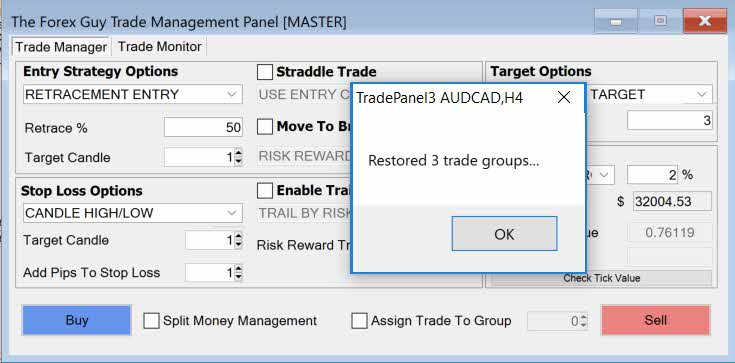
Trades are viewed by the panel as ‘groups’.
Some trade configurations may contain multiple trade tickets, like OCO and straddle trades. All the ticket numbers associated with each trade group will be shown in the trade monitor.
This save and restore feature is automated for your convenience. You don’t have to do anything on your end to make it work.
It is a huge headache saver, as many tools out there don’t offer restore features for things like trailing stops – so I addressed this issue and now the auto save and restore feature is working really well, and gives you peace of mind that your trades can be recovered if there is an issue.
Conclusion
This summarizes how the panel ‘works’ inside your metatrader environment. The panel has been designed for user friendliness and reliability with just a few small things for you to consider.
Simply load the panel and set up the trades how you want. Click buy or sell to execute the trade – and all variables are calculated for you, such as risk, spread and order type.
Just remember to keep one master panel open, to keep your trades maintained with the strategies you applied to them.
In the tutorials ahead, we will look at all the advanced trade strategy features the panel has to offer, and how they work.

Andre
Does the trade Manager work with Apple computer
Replying to: Andre
Dale WoodsAuthor
Only if you use it within a windows environment like parallels or virtual box.
Ann
Do i need to buy this trade panel or is for free?
Thanks
Ann
John
Can’t wait to check out these tools & strategies. Thanks mate.
Charles Ngwatle
Good day Dale,firstly I’d like to say thanks for the great content you are given us_I’m interested in your trade management panel,can I be able to obtain one without being a member on the war room_if the answer is yes
How much is it?
Regards
Charles
Brandan
Hi Dale. I’ve been trying to get ahold of your trade management panel but im really struggling. Where can i download it? Do i pay for it? What is it that i need to do?Please help
Replying to: Brandan
Dale WoodsAuthor
it’s part of the war room https://www.theforexguy.com/price-action-war-room/